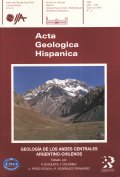Estratigrafía y estructura de los Andes Centrales Argentinos entre los 30º y 31º de Latitud Sur
Abstract
In a cross-section through the Argentine central Andes, two large groups of rocks can be distinguished: a Gondwanic (F'aleozoic) basement, and an Andean cover. The basement is constituted by manne sedimentary units, intruded by Upper Paleozoic granitoid rocks. The most important Gondwanic structures, are East verging thrust and related folds. The Andean cover has a volcanic and volcanoclastic origin with some interbedded continental sedimentary rocks. The lower Permo-Tnassic unit (Choiyoi Group) is linked to an extensional tectonic event, and a Neogene sequence is connected to a compressional tectonic event that produced the inversion of the previous extensional features. The amount of Andean shortening calculated fiom cross sections is of about 10%. Most of the shortening in the Andean Cordillera was transferred to the Precordillera through the detachment fault. The up-lift of the Pampeanas area is linked with a new lower detachment fault .


